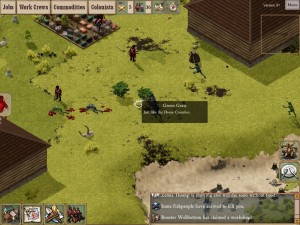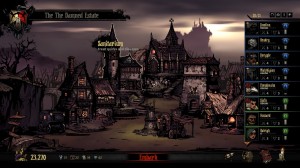A recent post on Gamasutra regarding Early Access got me thinking about the platform. Early Access like kickstarter has been embraced by game developers as a means of funding their games and getting the word out instead of the usual means. When it works, games like Invisible Inc, Darkest Dungeon and Prison Architect have been massive successes. When it doesn’t, you have games that either the developers disappear or the game fails to make any impression.
Having a successful Early Access cycle is about knowing what to do with the platform and how best to present your game; taking us to today’s post.
What’s Good:
Being on Early Access has several advantages with the first one being obvious: Money. Video game studios don’t make money until their game is released; meanwhile, the studio is burning through money from development and daily operating costs. Being able to develop your game while it’s being sold means that you can earn the money you need (and hopefully more so) while working on the game. If your game is a huge success, you can extend the development, making the game even better, such as Prison Architect.
Another more subtle advantage is all the free testing and breaking down your game that you’ll get from Early Access fans. As a developer, it’s easy to get lost in the design process and not see how your game is looking from the consumer. With Early Access, you’ll get hundreds if not thousands of people who are able to tell you what they think of the game and provide free support and testing in the process.
In turn, you’re able to make a more refined title, and perhaps find things that could have been problems down the line and stopped them at the alpha/beta phase. With large games built around complicated engines and design, having so many people look at your game, allows you to have people testing all kinds of variables and variants; possibly finding weird bugs that you would never have found on your own.

Duskers is one of many Early Access titles that has improved thanks to critiques from the fans playing it in beta.
In an upcoming cast, I spoke with Tim Keenan from Misfits Attic about Duskers who talked exactly about that, and how the Early Access testers caught bugs that would have caused problems that he wouldn’t have found until it was release day.
He also talked about how he was able to bounce ideas off of his fan base and see how they responded to changes; again, making Duskers as a whole, better than it would be if it was just released without the additional eyes on the game.
These reasons are exactly why so many developers are flocking to Early Access and putting games of varying quality and completeness on the platform, but there is a dark side to this.
When Things Go Wrong:
Going on Early Access with the intention of selling a barely designed prototype and getting enough funding for years is not how Early Access works. Consumers have been burned before with developers giving up, disappearing or releasing a game too soon in an attempt to cash out.
As with Kickstarter, the more developers who do things wrong, the more the consumers will be turned off of the model. What’s worse about Early Access is that the people who are buying your game are not the same as the Kickstarter community. Steam consumers expect results; if they’re spending their money on your title, they expect a finished game with everything promised by your store page. Failing to do so will not only doom your current project, but any future titles you try to get developed on Early Access.

Prison Architect’s success has become the poster child for Early Access success, and something that everyone is trying to achieve for their game
This is what has made a lot of developers nervous about going on Early Access. You’re not showing someone a finished game, but your title at its rawest, and many developers don’t like people peering behind the curtain.
With that said, you can see that there are major benefits and risks to using Early Access, which takes us to what you need to know and do in order to have the greatest chance at success.
1. Knowing When to Unveil:
It’s very tempting to put your very first prototype of your game up on Early Access with the intent of getting the funding to turn it into your dream game, but the consumers on Steam have gotten wise; you cannot sell a raw prototype with the promise that something good will come out of it.
On the other hand, waiting until your game is 80% done may not be in the cards; you may not have the funding on your own to sustain development that long.
Even though you can’t put your best foot forward when going on Early Access, that doesn’t mean you still can’t show something promising. Your game should be at the point where you can show off your main gameplay mechanic: The thing that is going to sell your game when it’s done. Is it supposed to be complete? No. Is it supposed to be fine-tuned and balanced? No. What it should be is something that a person can play and tell whether or not this is the game for them.
While Darkest Dungeon, Prison Architect and Duskers all were put on Early Access at different stages of their design, one thing was clear, someone could play each game and see exactly how the game is supposed to work. Don’t try and sell me a grand Minecraft variant by releasing a prototype where you can’t even stack bricks on top of each other.

Spacebase DF-9 was an example of what not to do on Early Access, and was one of the major failures on the platform
More importantly, however your game is like when it first gets on Early Access, should be reasonably close to where it is when the game is released.
Your Early Access title should be a representative of the final thing; if you have to change designs or create something radically different from that, then there was a major problem with your game.
The next point is one that a lot of developers have trouble with: Failing to communicate.
2. Don’t Keep Quiet:
Game developers are notorious for disappearing for months at a time to work on a game; maybe coming up for air to make a quick blog post and then disappearing for another few months. With Early Access, you cannot do that; consumers need to be assured that you are working on the game.
With Spacebase DF-9 from Doublefine, they had a colossal failure with the game and expecting to get five years’ worth of development funding through Early Access. Their other big mistake was disappearing and not working on the game for several months and doing their game jam session. What happened was that consumers saw that there weren’t any updates and thought the game was dead and just moved on to something else.
It is vitally important that you keep updating people as to what’s going on with your game; both on your own game site and on the Steam forums. Gaslamp Games has been doing exactly that with posting on their forums, Steam forums and having a development blog. The blog shows everyone what’s going on, what they are working on now, what’s coming and at what point will the game be finished to their standards.
Introversion Software may not have talked on the Steam forums, but they released monthly public videos detailing what’s going on with the game. These videos showed exactly what has been done with the game over the last 30 days, and talked about what’s coming next. That way, anyone who bought the game or was interested in it could see exactly the development scope and progress.

Clockwork Empires by Gaslamp is updated once a month with frequent blog posts and information from the developers
I can’t stress enough how important it is to keep updating people on what’s going on, especially if you are trying to use Early Access for long-term funding. One of the sure signs that a project is in trouble is when the developers go dark, and people know this. Keeping people engaged and informed is the best way to prevent morale from dropping among your fans, and it takes us to our final point.
3. Show Your Work:
Telling people that you are hard at work and making a great game is not the same as showing them, and consumers expect to see results. One of the harder elements to balance with working on an Early Access title is knowing when to update the Early Access build.
The more you update, the more progress people will see, but that comes at a price. For every new update you make on your Early Access build, means that you need to spend additional time fixing any bugs and making sure that the current build is stable, because the version that’s playable at the moment is the current representation of your game.
Speaking to multiple developers, studios like RageSquid who did Action Henk started with once a week updates to their Early Access build, but then found that they were killing themselves between working on the build for the week, fixing any bugs and still making overall process with the development.
A general consensus from speaking to developers is that bi-weekly or once a month patches is preferable. There are some exceptions, such as Darkest Dungeon having massive content patches every few months or the game Stonehearth which opted for major patches every three months, and smaller ones in-between. The point is that you should find an update schedule that works for you and then keep to it.
By keeping to your own schedule, it does several things to the perception of your game. First, people will see that you hard at work and know that you haven’t abandoned the title. Keeping to regular updates also allows you to turn those into mini-events; raising excitement for your game and making sure that people don’t forget about it.
Both Darkest Dungeon and Clockwork Empires have done this during their Early Access periods (Clockwork Empires is still being worked on at this time.) Major content updates were met with announcements and promo graphics to help spread awareness.

Darkest Dungeon only had a few major updates during Early Access, but they became marketing events that provided more buzz throughout the EA timeline.
If you’re going to go for a longer time between major patches, consider releasing beta patches in-between. These patches usually highlight what’s going on, but aren’t stable enough to be added to the official build.
This can be a win-win for the developer and consumer: The consumer gets an update and proof that the game is still being worked on, and the developer can get an even more discerning part of their audience to look at their latest version.
An Early Success:
Early Access is quickly becoming a popular and important tool for game developers when it is used correctly. For the games that have made it through Early Access to release, they are stronger and better designed than they would have been otherwise; thanks to the consumers being able to assist in testing and providing valuable feedback to the developer.
There is still one part of Early Access that we did not go over on this post: When do you release your game? The problem is that every game is different and outside of financial reasons, there isn’t a benchmark point we can discuss.
With all that said, there is one commonality I’ve heard from developers on Early Access who succeeded: They loved it and they’re going to do it every chance they can get. Be sure to look out for future podcasts with developers talking about Early Access; right now there is the one I had with Liam Welton from Failbetter Games, with more on the way.

